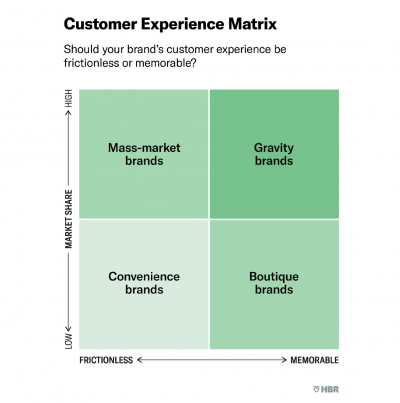Brands can be memorable or frictionless, but not both
For the past couple of months, I have been obsessing over a recent research piece published in the Harvard Business Review. Titled “What customer experience is right for your brand?”, authors Williams, Buoye, Keiningham and Aksoy argue that brands excel by delivering frictionless or memorable customer experiences but not both.
Skip to read why I can’t stop thinking about this article >
Frictionless brands deliver an easy, hassle-free customer experience. Mass market and convenience brands, such as McDonald’s or Uber, have been able to earn a high market share thanks to a frictionless approach.
Memorable brands are all about immersive experiences which resonate emotionally. IKEA, Disney Resorts and Lego were found to be strong examples in the study. These brands might leverage friction through the customer experience to create a distinct experience, such as the winding walkways through an IKEA warehouse, the high ticket prices for a Disney park or manipulating the tiny pieces of an architectural Lego set.
The study found that brands attempting to balance frictionless and memorable experiences were generally less successful than those which committed to a single strategy.
The authors note that friction and memorability are on a continuum with few brands on the extremes. For memorable brands, there is a need to reduce friction to ensure a positive customer experience. Frictionless brands still need to refresh customer engagement strategies to remain interesting.
Picking your battles: When to frictionless and when to be memorable
Now the part that has been keeping me up at night:
“Brands with high market share tended to be more frictionless, whereas more memorable brands tended to have lower market share with little appreciable growth above a 15% market share cap.”
While not particularly surprising, I felt a bit sad at the prospect of a world where everything was too easy; each desire fulfilled at the tap of a button without the need to speak to a person, go outside or even think.

There is some hope: Williams, Buoye, Keiningham and Aksoy encourage brands to identify their role and create an authentic customer experience that is true to the brand. They suggest using the “Customer Experience Matrix” as a framework for brands to clarify their strategy.
The article falls short for me in its evaluation of a memorable customer experience strategy. Other than a few exceptions of iconic, global brands which can reach the status of “gravity brands” (and are described as “so rare that there isn’t a conventional term for them”), it seems the goal to be memorable is not advised. Boutique brands, with a low market share and delivering a memorable experience, seemed to have little value in this study.
Of course, creating memorable customer experiences is costly and requires strong investment in staff training and organisational culture, digital and physical experiences, and quality product offerings. It’s not a cheap endeavour and the payoff in terms of market share appears to be limited.
The value of memorability
It seems the outcome of memorable experiences is a high emotional attachment for customers or a place in culture that transcends brand. If not market share, what is the value of a cult following for a brand? Customer advocacy and cultural capital have attracted attention from marketers and branding experts for some time, but why pursue these emotional goalposts?
Not all businesses are mass-market, widely relevant and offer a product that requires engagement regularly. It’s a Sisyphean task to focus only on squeezing sales out of customers, hopelessly pushing for people to buy more and buy more often.
Instead, niche brands create memorable experiences to elevate their brand equity which then opens new opportunities to diversify revenue streams through brand partnerships, sponsorships and brand extensions.
Lululemon has been particularly adept at building strong customer experience, first through its curated retail spaces, iconic reusable bags and by offering experiences such as in-store yoga. A strong brand manifesto created a committed customer base from the beginning, which has now enabled the brand to expand beyond yoga and into surfing, events and the high-tech Mirror home gym.
Memorability is a long-term game that is not frictionless; a cohesive strategy integrating customer experience, product development, and brand is required. Becoming frictionless can be equally as challenging with technology transformation and infrastructure upgrades to manage increased volume. But as summarised by Williams, Buoye, Keiningham and Aksoy: “No company should forget that managing customer experience is equivalent to managing customers for growth. The path to winning in business has remained constant even if the strategies for achieving it over time have changed: Make certain that your customers want to keep coming back.”




